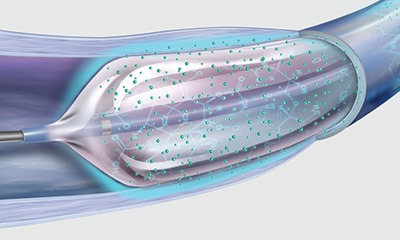
There in an increasing physician interest in exploring the role of drug-coated balloons in arteriovenous (AV) access. At the Leipzig Interventional Course (LINC; 30 January–2 February, Leipzig, Germany), Panagiotis Kitrou (Patras, Greece) presented the interim six-month outcomes of the Lutonix AV registry and Andrew Holden (Auckland, New Zealand) reported that the IN.PACT AV access investigational device exemption (IDE) study had completed two-thirds of its enrolment target.
Previous studies have shown that the use of drug-coated balloons in failing AV access fistulas results in significantly higher target lesion patency and far fewer reinterventions to maintain patency than standard angioplasty.

Lutonix AV registry
Kitrou, who presented the interim six-month outcomes of the Lutonix AV registry, explained that this was a prospective, multicentre, single-arm registry investigating the clinical use and safety of the Lutonix drug-coated balloon catheter for treatment of dysfunctional AV fistulas and grafts.
“At 180-days, the safety is consistent with Lutonix DCB reported outcomes. Efficacy outcomes show that target lesion primary patency is 74.9% and access circuit primary patency (ACPP) is 70.9%,” he revealed.
“The registry’s objective is to demonstrate safety and assess the clinical use and outcomes of the Lutonix DCB for treatment of dysfunctional AV fistulae located in the arm in a heterogeneous patient population in real-world clinical practice. Up to 300 patients will be enrolled at up to 30 international sites,” he said.
The primary efficacy endpoint is target lesion primary patency through six months and the primary safety endpoint is freedom from any serious adverse events involving the AV access circuit through 30 days. Clinical assessment is scheduled for patients at six months and clinical or telephone assessment at three and 12 months.
Kitrou reported that the interim data was based on 236 patients who had been enrolled and treated with a Lutonix AV DCB. “With regard to demographics, just over half were male; the mean age was 67 years with nearly 75% who had hypertension and just over 40% who had diabetes. Nearly 27% had dyslipidemia and nearly 8% were current smokers,” he said.
He made the point that the Lutonix AV registry is “the first and only global drug-coated balloon registry to include arteriovenous fistulae, grafts, central veins and restenotic lesions as well as in-stent restenosis. It includes a larger patient population than existing published data”.

IN.PACT AV access trial
Holden then presented an update from the IN.PACT AV access IDE trial to state that the objective of study is to evaluate the safety and efficacy of the IN.PACT AV access drug-coated balloon compared to percutaneous transluminal angioplasty for treatment of de novo or restenotic obstructive lesions of native arteriovenous fistulae in the upper extremity.
The principal investigators of the trial are Robert Lookstein (USA); Andrew Holden (New Zealand); and Hiroaki Haruguchi (Japan) and recruitment is ongoing in all these geographies.
This trial is a prospective, global, multicentre randomised single-blinded study that will include 330 patients who will be followed for two years. The trial is adopting a 1:1 randomisation model and will include patients who have lesions that are up to 10cm in length.
Inclusion criteria
“The vessel diameter needs to be between 4 and12mm by visual estimate and includes patients with de novo or non-stented restenostic lesions located between the arteriovenous anastomosis and axillosubclavian junction with less than or equal to 50% stenosis. There is the possibility to include tandem lesions as long as certain conditions are met.
Holden commented on the importance of vessel preparation, “Predilation with a high pressure balloon catheter is extremely important so that the residual stenosis is less than or equal to 30% and there is an absence of a flow-limiting dissection or perforation.”
The primary safety endpoint is a serious adverse event rate involving the AV access circuit through 30 days post procedure. The primary efficacy endpoint is primary patency rate through six months defined as freedom from clinically-driven target lesion revascularisation (CD-TLR) or access circuit thrombosis measured at six months post-procedure. Holden explained that the IN.PACT AV access primary patency is measured out to 210 days endpoint rather than 180 days.
There were nearly 64% diabetic patients in the cohort and 40.8% had concomitant peripheral arterial disease, with the vast majority having undergone a previous revascularisation.
“Baseline clinical and lesion characteristics reflect the early recruitment and geographic distribution and are likely to change with full recruitment. Patient enrolment is around 65% completed,” noted Holden.










